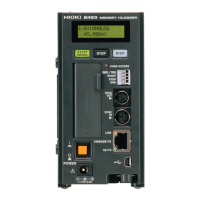5.4 Advanced Settings for Each Channel
94
Measuring Pulses (Rotation Rate)
The instrument measures the pulses output according to the rotation rate of a
rotary encoder, rotation meter, etc. The rotation rate is obtained by counting the
number of pulses input for a one-second period. Use of the scaling function
enables converting the measured rotation rate to the physical quantity of the
measurement object to perform measurement.
Measurement Principle of the Rotation Rate
When the range is set to "Rotation Rate," the number of pulses is totalized inter-
nally every 10 ms.
The rotation rate r at time t [s] is calculated by dividing the number of pulses from
(t-1) to t [s] by the number of pulses per rotation.
Example: Pulses per rotation = 4
When 1 s, totalized number of pulses P10 = 1000 counts
When 2 s, totalized number of pulses P20 = 2000 counts
In this case, the rotation rate r
t=2
for t = 2 s is calculated as follows:
When time t [s] < 1 second
The totalized number of pulses of t-1 [s] is not measurable, so the value that is a
hundred times the totalized number of pulses between t-0.01 [s] and t [s] is cal-
culated as the totalized number of pulses during 1 s in order to calculate the rota-
tion rate. For this reason, the rotation rate when t is less than 1 second may vary.
20 ms
10 ms
P
200
2 s
1 s
0
0
P
1
P
2
P
100
Pulse / Rotation rate
Totalized number of pulses at t [s] - totalized number of pulses at (t-1) [s]
r =
[rps]
2000 - 1000
4
= 250 [rps]
r
t = 2
=
Pulse / Rotation rate
(Totalized number of pulses at t [s] - totalized number of pulses at (t-0.01) [s])
r =
[rps]
× 100

